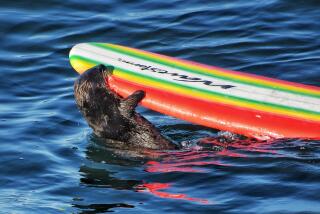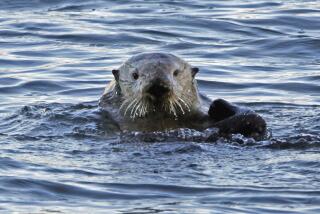Sea Otter Population Booms Amid Hunting Ban : Alaska: Biologists call it an amazing success story. Natives envision a lucrative fur trade. But conservationists fear there will be abuses.
- Share via
JUNEAU, Alaska — A remarkable comeback of Alaska’s sea otters may revive an international trade in the otter’s dark-brown fur pelts not seen since the animals were hunted to near extinction a century ago.
Alaska Natives, the only people allowed to hunt otters under federal law, have been harvesting growing numbers in southeast Alaska. They are trying to develop worldwide markets for otter products, from “dance blankets” to sex organs as aphrodisiacs.
“It could do more wonders for your love life than the sea lion, or deer, or other velvet horns, or bear bile,” says a brochure touting otter products.
The growth in otter hunting follows a recent federal court decision that broadly defines the sea otter products Alaska Natives can make and sell. Federal law still bans the sale of raw pelts. They must be altered into handicrafts for sale, but what constitutes alteration remains unclear.
Conservationists and tour boat operators say too many otters are being killed. Some accuse a handful of Natives of violating the law’s intent by trying to export pelts that have been minimally altered.
The state Department of Fish and Game, commercial fishermen and Natives said the growing otter population poses a nuisance. The otters compete with fishermen for abalone, sea urchins and other shellfish.
“They’re out there multiplying as fast as rabbits,” said Embert James, a Tlingit Indian and commercial fisherman from Ketchikan.
“First we had white fishermen taking all our seafood. Now we have the sea otters, who are even more dangerous. Gee, when they eat two-thirds of their weight in seafood a day, that’s a lot of seafood.”
Southeast Alaska’s sea urchin population has plummeted by about two-thirds in the last year, and biologists attribute most of the decrease to otters.
Doug Woody, a state fisheries biologist, said the state will close the sea urchin fishery in Sitka Sound next year because of the effect of sea otters.
Tony DeGange, a sea otter expert with the U.S. Fish and Wildlife Service, said about 750 otters have been reported killed by native hunters so far this year. In recent years, hunts have averaged about 200. Most of the hunting is being done out of Sitka, Hoonah and Ketchikan.
No state or federal agency can regulate the Native hunts unless the statewide population of sea otters is threatened. The Fish and Wildlife Service tags and keeps data on harvested otters. It has taken no position on whether the hunts need to be limited.
James said he and his brothers have spent up to $150,000 on phone calls and travel to Asia and Europe to market otter products.
“We just have to get the product samples there to let them look at,” he said. “We could make coats out of them, we could make shawls, we could make dancing blankets.”
William Pfeifer of Ketchikan, also a Tlingit Indian, helped set up Alaska Native Fur Products in December to sell sea otter products to tourists from cruise ships.
The Alaska otter trade, started by Russians in the 1700s, dwindled to almost nothing as the animals were over-hunted in the late 1800s.
The sea otter population in the Pacific was estimated at 2,000 in 1911, when hunting the mammal was banned by international treaty.
Federal biologists now think they number between 100,000 and 150,000 in Alaska alone, close to estimates of their historic high levels here, DeGange said.
“I just call it a great conservation success story,” DeGange said. “For something that was clearly endangered to be able to go almost back up to its historical high is clearly amazing.”
Stephen Wells, executive director of the Alaska Wildlife Alliance, disputes the idea that sea otters are nearing their historic levels.
“We hear about this big comeback, but I can absolutely say that there are clearly very large expanses of sea otter habitat without otters,” he said. “So it’s not a complete recovery.”
Wells said Native groups are trying to find foreign buyers for sea otter dance blankets, which usually consist of just two pelts sewn together. The idea is to have foreign buyers unstitch the blankets to get relatively untouched pelts, he said.
Kuiu Kwan Inc., based in Lynnwood, Wash., and run by James’ brother Franklin, has sent brochures touting potential products to the U.S. Embassy in Tokyo, and has asked for marketing help in Japan.
One of the brochures has photographs of a dance blanket with this caption: “Bottom ends of sea otter will be sewed together. This what we will call a blanket. The sewing could be pulled apart easily.”
The company also is marketing sea otter sex organs as an aphrodisiac.
Such marketing makes conservationists cringe.
“This is exactly what was not supposed to happen,” said David McCargo, an alliance board member. “The intention was to have sort of a cottage industry of authentic Native items.”
DeGange said Justice Department lawyers are working on clarifying the federal regulations in response to inquiries from Kuiu Kwan and other companies about the legality of such sales.
Under the Marine Mammal Protection Act, the federal government assumed jurisdiction over all marine mammals. An exemption for Alaska allows coastal Natives to take some animals for subsistence use and crafts.
Sea otter hunting was not considered traditional among Natives and remained banned until a 1984 court decision won by a Native group.
A 1991 federal court decision in Anchorage clarified that Natives could make and sell a broad array of sea otter products as long as they were made in traditional ways, such as hand sewing, rather than mass-produced.
The federal government and conservation groups appealed the case. But the government dropped out and the appeal was dismissed in December, putting the decision in effect.
McCargo said the Marine Mammal Protection Act, up for reauthorization by Congress, should be updated with more specific language on what kind of otter trade in handicrafts should be allowed.
The federally funded Sea Otter Commission, an Alaska Native group set up in 1988, is working with hunters in southeast Alaska on the otter-management plan.
Mara Kimmel-Hoyt, commission president, said she is not familiar enough with the operations of Kuiu Kwan Inc. or Alaska Native Fur Products to say whether the panel supports the businesses.
“We are urging Alaska Natives to take only what they need for subsistence and handicrafts. We definitely embrace that. That’s what we fought for.”
More to Read
Sign up for Essential California
The most important California stories and recommendations in your inbox every morning.
You may occasionally receive promotional content from the Los Angeles Times.













